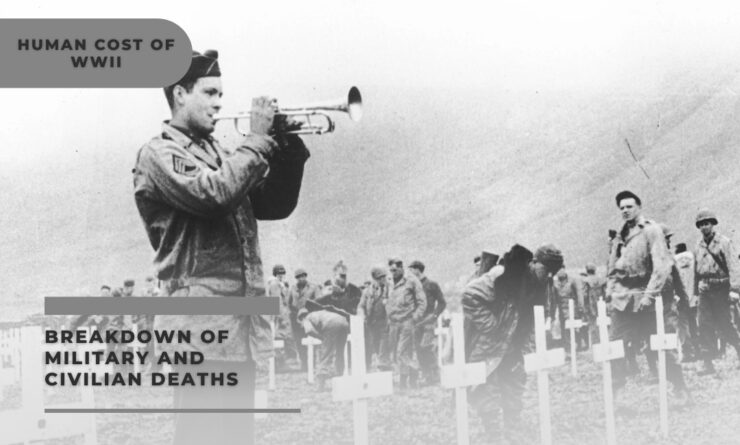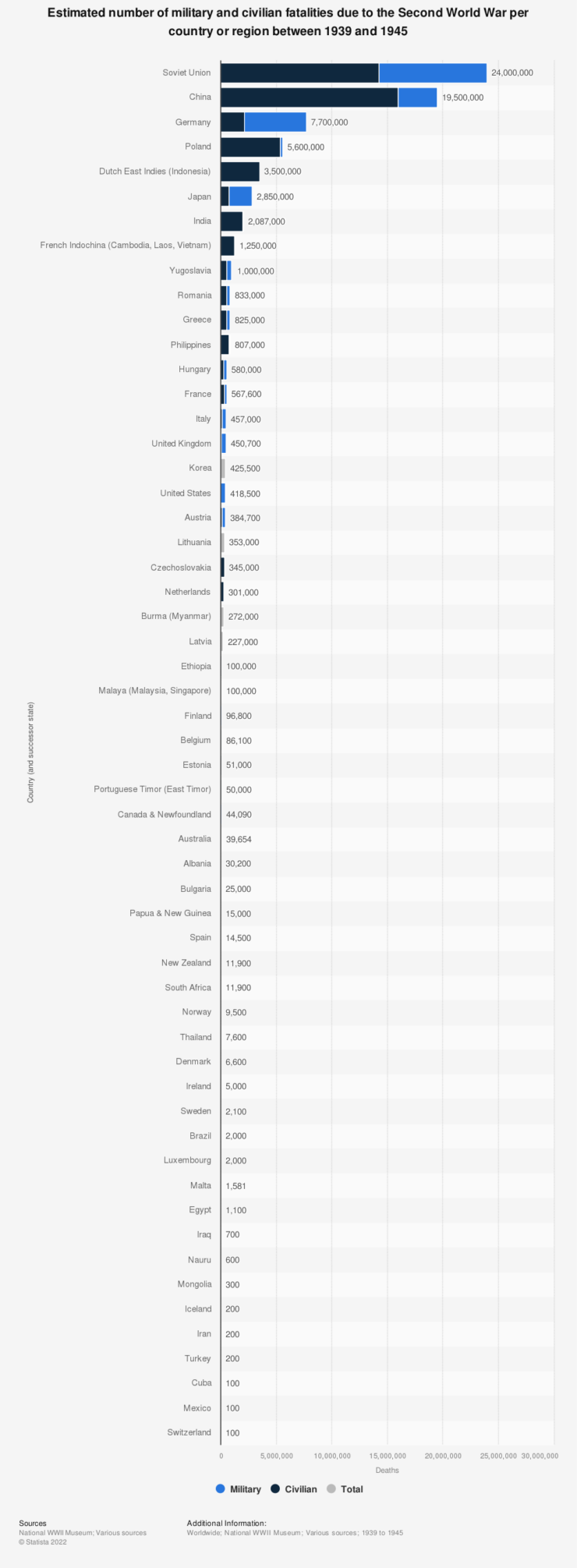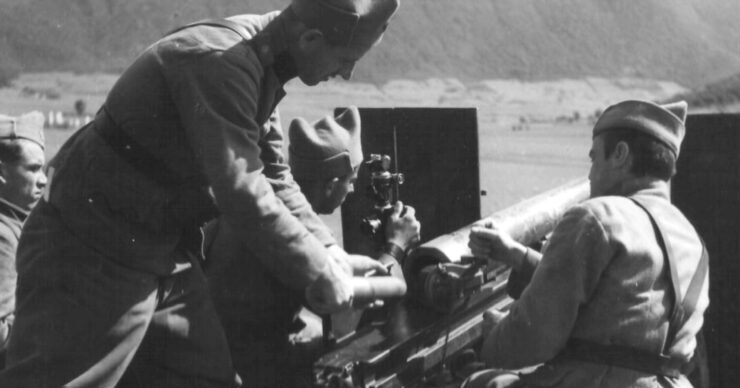The Second World War remains one of the deadliest conflicts in human history, with an estimated 60 to 85 million people killed between 1939 and 1945. The war affected people from all walks of life and every corner of the world. It is essential to examine the impact of this global catastrophe on a national and regional level to understand the scale of human suffering and loss.
This article will provide an overview of the estimated number of military and civilian fatalities in the Second World War for each country or region. While it is impossible to give an exact figure for each country, these estimates provide a general understanding of the immense toll the war had on humanity.
| Country/Region | Estimated Military Fatalities | Estimated Civilian Fatalities | Total Estimated Fatalities |
|---|---|---|---|
| Soviet Union (USSR) | 8,668,000 | 17,000,000 | 25,668,000 |
| China | 3,000,000 | 12,000,000 | 15,000,000 |
| Germany | 3,250,000 | 2,050,000 | 5,300,000 |
| Poland | 240,000 | 5,360,000 | 5,600,000 |
| Japan | 2,120,000 | 580,000 | 2,700,000 |
| Yugoslavia | 300,000 | 700,000 | 1,000,000 |
| Romania | 300,000 | 200,000 | 500,000 |
| Hungary | 200,000 | 400,000 | 600,000 |
| France | 250,000 | 350,000 | 600,000 |
| Italy | 300,000 | 200,000 | 500,000 |
| United Kingdom | 384,000 | 116,000 | 500,000 |
| United States | 405,000 | 15,000 | 420,000 |
| Other countries | Varies | Varies | Varies |
Death toll estimates for World War II typically range from 70 to 85 million people. The Soviet Union experienced the highest number of fatalities among nations, with estimates varying from 22 to 27 million deaths. China faced the second highest death toll, around 20 million, though these numbers are less certain and often intertwined with the Chinese Civil War.
Over 80% of all deaths were from Allied nations, predominantly civilians, while 15-20% were from Axis powers, primarily military deaths, as evidenced by Germany and Japan’s death ratios.
Civilian fatalities and atrocities It is estimated that 60-67% of all deaths were civilian casualties, mainly due to war-related famine, disease, war crimes, or atrocities. Systematic genocide, extermination campaigns, and forced labor, especially by Germans, Japanese, and Soviets, caused the deaths of millions.
Nazi actions alone led to 17 million deaths, including six million Jews in the event now known as the Holocaust. The conflict’s scale, nature, and reasoning for this immense loss make World War II one of the most devastating and brutal wars in history.
Challenges with these statistics Although the war is considered a defining event of the 20th century, exact death toll figures are challenging to determine for various reasons. Countries like the U.S. have relatively consistent estimates due to preserved military records and fewer civilian casualties, but numbers still differ by source.
In much of Europe, records are less precise. Pre-war records for many regions were already poor or non-existent due to border fluctuations and interwar turmoil. The war’s swift and disorderly nature made accurate death records difficult to maintain, and mass displacement or forced relocation led to civilian deaths outside their homeland, complicating country-specific data.
Early estimates of war fatalities were often accepted without scrutiny and became the foundation for many historical works, leading to continued use of inaccurate figures despite contrary evidence.
Compared to Europe, estimate ranges are often wider in Asia, where larger populations had limited pre-war data. Many Asian countries with high death tolls were European colonies, and metropole authorities’ actions, such as diverting resources from Asia to Europe, caused millions of deaths through famine and disease.
Over one million African soldiers were conscripted into European armies during the war, but individual statistics are mostly unavailable for these colonies or successor states (notably Algeria and Libya). Numerous Asian and African military deaths went unrecorded or were combined with European or Japanese data, and reliable figures for millions of deaths from countries across North Africa or East Asia are lacking.
Furthermore, many concentration camp records were destroyed, and such records in Africa and Asia were even scarcer than in Europe. Despite World War II being a heavily researched academic subject, it is improbable that we will ever have an accurate count of the lives lost in the conflict.
1. Soviet Union (USSR)
The Soviet Union suffered the highest number of fatalities in the Second World War. It is estimated that around 26 to 27 million people lost their lives, including both military personnel and civilians.
The majority of the casualties occurred on the Eastern Front, where the Soviet Union fought against Nazi Germany and its allies. The Siege of Leningrad, the Battle of Stalingrad, and Operation Barbarossa were some of the deadliest campaigns that resulted in millions of casualties.
2. China
China was one of the first countries to experience the horrors of World War II, as the Japanese invasion began in 1937. While the war officially started in 1939, the conflict between China and Japan escalated in the preceding years.
It is estimated that between 15 to 20 million Chinese people, both military and civilian, perished during the war. The majority of the deaths occurred due to military actions, but there were also mass killings, forced labor, and famine.
3. Germany
Germany, the primary instigator of World War II, experienced significant losses as well. The total number of German military and civilian fatalities is estimated to be around 5.3 million.
The majority of the deaths occurred on the Eastern Front, where the German military faced the Soviet Union. Additionally, millions of German civilians were killed or died due to forced labor, bombings, and starvation.
4. Poland
Poland was the first country to be invaded by Germany and later by the Soviet Union, which marked the beginning of the Second World War. The country experienced significant losses, with an estimated 5.6 to 6 million Poles losing their lives during the conflict.
This figure includes both military personnel and civilians. The Holocaust, in which around 3 million Polish Jews were killed, accounted for a significant portion of these fatalities.
5. Japan
Japan, one of the Axis Powers, also experienced significant losses during World War II. An estimated 2.7 to 3.1 million Japanese people died as a result of the conflict, with the majority being military personnel. The United States’ strategic bombing campaign and the atomic bombings of Hiroshima and Nagasaki caused significant civilian casualties, as well.
6. Yugoslavia
Yugoslavia suffered substantial losses during World War II, with an estimated 1 to 1.7 million fatalities, including both military personnel and civilians. The country was invaded by the Axis Powers and experienced a brutal occupation, along with a complex civil war and various resistance movements. The Holocaust also claimed the lives of around 60,000 Yugoslav Jews.
7. Romania
Romania, an Axis ally that later switched sides to join the Allies, experienced significant losses during World War II. The country is estimated to have lost between 400,000 to 500,000 people, including military personnel and civilians. Romania faced a brutal occupation by the Soviet Union and was subjected to bombings by the Allies.
8. Hungary
Hungary, another Axis ally, suffered significant casualties during World War II. It is estimated that between 300,000 to 600,000 Hungarians lost their lives, including both military personnel and civilians.
Hungary faced invasions from both the Soviet Union and Nazi Germany and was subjected to bombings by the Allies. The Holocaust also resulted in the deaths of around 400,000 to 450,000 Hungarian Jews.
9. France
France was invaded and occupied by Nazi Germany in 1940, leading to significant military and civilian casualties. It is estimated that between 500,000 to 600,000 French people died during World War II, including military personnel and civilians.
The French Resistance played a significant role in the fight against the Axis occupation, and many French citizens were killed in reprisals or sent to concentration camps.
10. Italy
Italy, one of the Axis Powers, experienced considerable losses during the conflict. The country is estimated to have lost between 400,000 to 500,000 people, including military personnel and civilians. Italy faced a brutal occupation by both the Allies and the Axis Powers after the fall of Mussolini, leading to widespread destruction and civilian casualties.
11. United Kingdom
The United Kingdom, one of the leading Allied Powers, experienced significant losses during World War II. An estimated 450,000 to 500,000 British people died during the conflict, including military personnel and civilians. The UK faced a sustained bombing campaign by the German Luftwaffe during the Blitz, which resulted in significant civilian casualties.
12. United States
The United States, another leading Allied Power, suffered losses during the conflict, though they were relatively low compared to other nations. It is estimated that between 400,000 to 420,000 American people died during World War II, with the majority being military personnel. The US faced minimal civilian casualties on its home soil due to its geographic isolation.
13. Other countries and regions
Many other countries and regions experienced significant losses during World War II, though they may not have been directly involved in the conflict. For instance, India, which was a British colony during the war, lost an estimated 2.1 to 2.3 million people due to war-related famine and other consequences. Additionally, countries such as the Netherlands, Belgium, and Greece suffered hundreds of thousands of casualties during the conflict.
FAQ:
What were the human costs of ww2?
The human costs of World War II were immense and far-reaching. The conflict resulted in an estimated 60 to 85 million deaths, making it one of the deadliest wars in human history. These losses included military personnel and civilians from countries and regions all over the world. The human costs can be categorized as follows:
- Military casualties: Millions of soldiers lost their lives on various battlefronts, with many more wounded or taken as prisoners of war.
- Civilian casualties: Civilians were killed due to bombings, invasions, and other military actions, as well as due to indirect consequences such as famine, disease, and displacement.
- Holocaust: Approximately 6 million Jews, along with millions of other “undesirable” groups like Romani people, disabled individuals, were systematically exterminated by the Nazis.
- Forced labor: Millions of people were subjected to forced labor under harsh conditions in concentration camps, labor camps, or as “forced laborers” for the Axis powers.
- Displacement: Millions of people were displaced from their homes, either as refugees or due to forced relocation or evacuation, resulting in long-lasting social and psychological consequences.
- Psychological trauma: The war left countless survivors and witnesses traumatized, leading to long-term mental health issues and emotional suffering.
- Economic and infrastructural devastation: The war led to the destruction of cities, towns, and infrastructure, resulting in massive economic costs and the need for rebuilding efforts.
- Post-war consequences: The human costs of World War II continued even after the conflict ended, with many survivors struggling to rebuild their lives, and political tensions leading to the Cold War and other conflicts in the following decades.
Conclusion
The Second World War was a cataclysmic event that caused immense suffering and loss of life across the globe. The estimated number of military and civilian fatalities per country or region provides a glimpse into the devastating impact of the conflict on humanity.
It is important to remember these staggering figures as a reminder of the human cost of war and the need to strive for peace and understanding among nations.



















